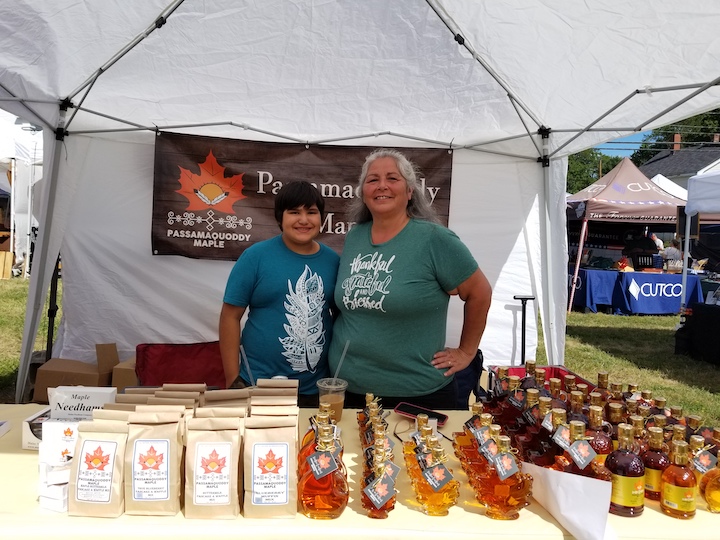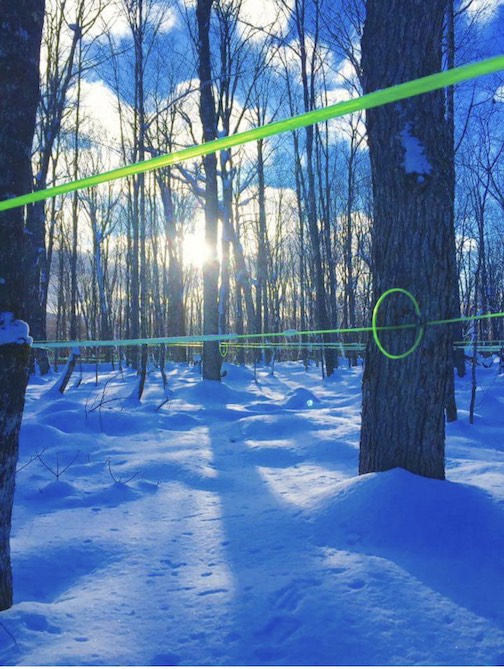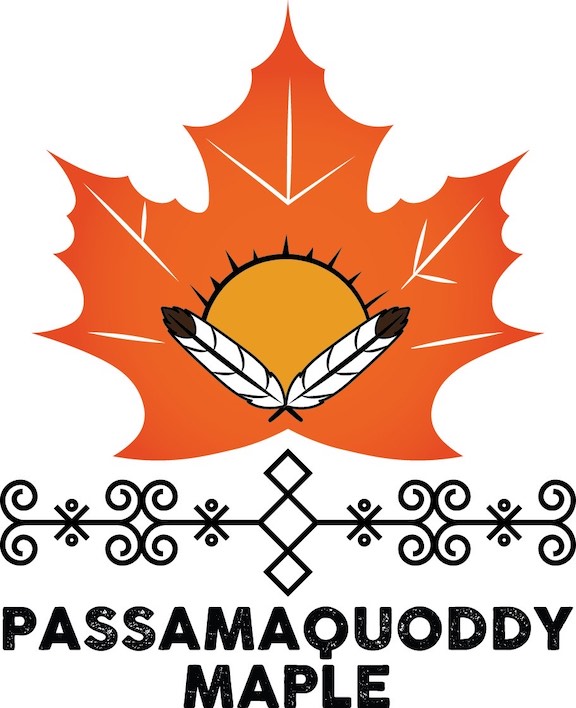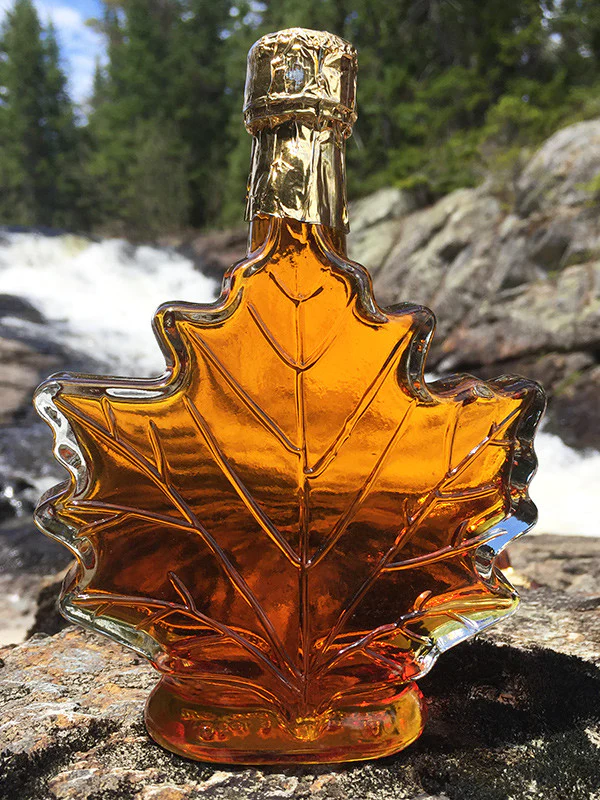By Sonja Heyck-Merlin
To make apple pie, Vanessa Harnois, an employee at Passamaquoddy Maple headquartered in Jackman, Maine, first soaks the apples for 30 minutes in some very dark maple syrup. After the marinade, she mixes in granulated maple sugar and the rest of the ingredients before sealing them into the crust. “It’s just phenomenal,” she says. “It really brings out the flavor in the apples. I am telling you. You have to try it.”
Vanessa and her mother, Marie Harnois, who is the operations manager at Passamaquoddy Maple, are members of the Passamaquoddy Tribe of Indian Township, Maine. So are all of the company’s employees. It’s a 200-mile four-hour drive from Indian Township, located along the St. Croix River in far eastern Washington County, to the headquarters in far western Maine. For Vanessa and Marie, the sweet smell of boiling sap, the crimson red of autumnal maple stands and working for an Indigenous-owned enterprise make calling both places home worth it.

In the mid-1980s, the Passamaquoddy Tribe bought 40,000 acres in Franklin and Somerset counties as part of the Maine Indian Claims Settlement Act. Jackman is close to Quebec, which is the world leader in maple syrup production. Somerset County holds its own though; it actually produces more maple syrup than any other county in the United States.
With 14,000 taps, Passamaquoddy Maple is small in comparison to some Somerset County producers who trek through steep terrain placing as many as 100,000 taps. Still, Passamaquoddy Maple produces more than enough syrup to supply a robust clientele of wholesale and retail customers. All of it is MOFGA certified organic.
Culturally, the Passamaquoddy are one of several tribes of the Wabanaki, also known as the People of the Dawnland. The ancestral home of the Passamaquoddy Tribe once covered 3 million acres, including the entire St. Croix River watershed, and extended into New Brunswick, Canada. Now, the tribe owns about 150,000 acres.
Maple traditions run deep for the Passamaquoddy Tribe. According to Donald Soctomah, a member of the tribe and its tribal historian, the Great Spirit created the maple tree to produce the sweetest sap as a gift to the people. Soctomah says he likes to put syrup on many things that he eats and that in the past the Passamaquoddy put it on fish. He also says that in their communities, the children love maple candy.
“Gathering the maple sap started a long time ago, many thousands of years ago,” Soctomah says. “In the past, a hatchet was used to cut an opening through the bark and a piece of birch bark was placed in the opening, which allowed sap to drop into a birch bark container. Once enough was collected, a fire was started and smooth rocks were heated up until they were glowing red. These hot stones were dropped into the birch bark container, evaporating the water. This was continued until the taste was just right.”
The Passamaquoddy Tribe long recognized the potential for a commercial-scale sugaring operation on their western Maine land, but it wasn’t until 2014, when they received a federal grant from the Administration for Native Americans, that the dream became a reality. With the grant, they purchased equipment, including tubing infrastructure, an evaporator and bottling equipment. They also constructed a 45-by-70-foot steel sugar house located downhill from their maple stands. Subsequently, they received a grant from the Northern Border Regional Commission, which helped them grow the operation by adding a larger processing and shipping facility to its Jackman headquarters along Route 201.

To get to the off-grid sugarhouse, it’s a 9-mile drive along a rough and often muddy dirt road. Through the late fall and early winter, the woods crew commutes to the sugar bush, focused on maintaining and repairing the miles-long web of sap lines and main lines, which bring sap to the sugarhouse. The goal is to maintain a five-degree pitch on all lines to assist gravity.
The maple stands are located near the boundary mountains between Maine and Quebec, mostly growing on the southern side of the mountains where the sunlight helps the trees experience maximum growth. Passamaquoddy Maple uses timber stand improvement to increase the growth and health of the trees, and only the largest and healthiest trees are tapped.
These practices are in accordance with the MOFGA Certification Services organic maple syrup certification guidelines, in which producers are expected to manage sugar bushes using accepted forestry practices such as thinning that selects for healthy, vigorous trees and a stand composed of mixed young and mature maples, as well as other tree species. Producers are expected to minimize impact to the forest and trees.
“Organic certification aligns with our beliefs as a tribe,” Marie says. “The trees are what give us the sap, and we need to take care of them.”
When tapping starts in early February and the oil-fired evaporator roars to life, someone is always at the sugarhouse: sleeping in its living quarters and prepared to respond to any logistical hurdles that arise during the furious boiling season.
With its 14,000 taps, Passamaquoddy Maple needs nearly 20,000 gallons of sap storage capacity. They use a system of tanks and pumps to carry the sap from the trees — some of which are a mile from the sugarhouse — to the evaporator. Vacuum is used on all the lines to maximize sap production.
To increase efficiency and burn less fuel in the evaporator, they remove some of the water in the sap through reverse osmosis. When sugar makers talk about the sweetness of sap or syrup, they talk in the language of the Brix scale; the Brix scale is based on degrees, where 1 degree Brix is equal to 1% sugar. At Passamaquoddy Maple, they use a digital hydrometer to test Brix levels. “We’re taking sap that is 2.0-4.0 degrees Brix depending on the season and removing all that water to move it up to 16-17 degrees Brix,” says Marie.
Once they’re at 16-17 degrees Brix, or 16-17% sugar, they turn some valves, and the more concentrated sap flows into a Master brand evaporator. Unlike boiling in a simple barrel evaporator, with a commercial evaporator a gradient is formed causing the heavy syrup to move in front of the lower density sap. If the pan is boiling, then the two will not mix unless the temperature of one section of the pans is suddenly lowered.
“When I turn on the evaporator, it’s the most magical thing ever,” says Marie. “Everything that has happened in the field is that moment right there. It’s hard to describe when the steam starts rolling and the smell fills the sugarhouse. It’s truly a blessing to be part of it.”
Marie isn’t, however, sitting down warming her hands when the evaporator is cranking; she calls it her “go time,” and she is always looking for the “sweet spot.” A modern evaporator of this size can boil off hundreds of gallons of sap each hour. Getting to that “sweet spot” requires unrelenting attention to a myriad of pumps, gauges and valves. With only 2 inches of liquid in the pan and a stack temperature of 600-1,000 degrees Fahrenheit, Marie says “everything can go wrong in the blink of an eye.” The evaporator is equipped with level indicators, so the operator always knows how much liquid is in the pan. In order to get an accurate reading, it’s important to control the foam that forms on the surface of the syrup. Because Passamaquoddy Maple is certified organic, they use organic safflower oil as their defoaming agent.
When the syrup at the front of the pan reaches 66-67 degrees Brix, or 216-218 degrees, Marie turns a valve and the syrup flows into the draw off pan. Then, she adds in diatomaceous earth — a mined product consisting of the fossilized remains of diatoms — which is commonly used as a filtration aid in food processing. After the diatomaceous earth is added, the syrup enters a 16-frame filter press. Between each of the frames is a piece of filtration paper, and a small pump pushes the syrup through each layer, removing all of the impurities (mostly minerals) and resulting in a crystal-clear syrup. Finally, the syrup is pumped into 40-gallon stainless steel barrels.
According to Marie, all the maple syrup produced in Somerset Country is great, and she expressed gratitude for the support and consultation of the producers in the neighborhood. From here, it’s the story behind Passamaquoddy Maple that helps distinguish it in the marketplace. For Marie, who left her job as the executive director of the Indian Township Housing Authority to join Passamaquoddy Maple, there is a special pride that comes with taking an Indigenous product to market — “tree-to-table,” she calls it.
“A lot of people in Maine don’t realize there are tribes here, that there really are Indigenous people. Passamaquoddy Maple brings a lot of awareness,” says Vanessa. “We also love seeing our tribal name out there in a positive way that people are excited about.”

When Passamaquoddy Maple needed a logo, they had a tribe-wide contest, which garnered 80 submissions. The panel of four judges couldn’t decide between the finalists, so they compromised and used a graphic designer to merge the two pieces of art created by Lou Dana and Tasja Nicholas. The logo features a large maple leaf with the sun in the center, flanked by two feathers. “The center is the sunrise, representing the People of the Dawn. When you look at the center you see who we are, and on the outside is what we’re trying to do,” Marie says.
According to Soctomah, feathers represent the Eagle. The Passamaquoddy Tribe believes that their ancestors look through the eyes of the eagle to watch over the land and people. The eagle feathers are also in their tribal logo. Below the sun, maple leaf and feathers is a design called the “double curve motif.”
“For some people it represents the spring coming of life, as the first growth of plants. For others the symbol represents the gathering of the Wabanaki tribes, each curl represents the different tribe and chiefs, the diamond represents the central fire we are connected to. The symbol also represents a canoe reflection which shows the importance of water in life. So, for many this symbol may represent a variety of different meanings,” says Soctomah.
This symbolic label is hand-placed on most of Passamaquoddy Maple’s products. On average, Marie bottles one to two 40-gallon barrels each week — in single-serve containers for restaurants, in shapely glass containers topped with gold foil and in quaint tins shaped like log cabins. Then, there’s the plastic quart or gallon jug for those who appreciate volume over the amber beauty of the syrup in a glass bottle.

They also make maple sugar by heating 2 ½ gallons of syrup to about 256 degrees. Once it reaches temperature, it’s transferred into a special sugar machine, which stirs the syrup for one hour until it’s transformed into flowable granulated sugar. Like her daughter Vanessa, Marie thinks maple sugar belongs in an apple pie. She also uses the sugar as a sweetener in banana bread.
About 50% of the company’s sales are retail, which includes internet sales and sales out of the Jackman office. The other half is wholesale to stores, coffee shops, restaurants and food processors, like The Maine Needham Company, which makes maple-sweetened potato candies. In 2021, Luke’s Lobster in Portland honored Indigenous Peoples Day with a fundraiser for Wabanaki REACH featuring Indigenous food businesses, including Passamaquoddy Maple. Wabanaki REACH is an organization led by Wabanaki people that supports the self-determination of the Wabanaki through education, truth-telling, restorative justice and restorative practices in Wabanaki and Maine communities.
Marie is eager to team up with more collaborators looking for high-quality organic syrup and sugar, and she also has some ideas for new maple products in the pipeline. She’s equally excited to share her knowledge. Pre-COVID, a group of Passamaquoddy sixth-graders from Indian Township had a chance to spend a weekend in Somerset County learning about the land and the business.
“We’re four hours from our reservation, so the kids see the syrup, but they don’t get to see where it’s made, where it’s bottled, and where the sap is coming from. As Passamaquoddy Maple expands, we’re going to be looking for marketers, for people to work in the woods, so we talked about the possibilities of different jobs,” Marie says.
And she certainly didn’t have much trouble finding student volunteers to conduct taste tests. Marie says that every single barrel gets sampled after it’s opened.
“I went from suits to Muck Boots,” Marie says. “It’s a lot of thinking on your feet, a lot of problem solving. There is this piece that I never truly knew about being out in the woods. There is a peace that is just truly amazing. The connection with nature is just awesome — that connection and that pride of taking an Indigenous product to market.”
About the author: Sonja Heyck-Merlin is a regular feature writer for The MOF&G. She and her family own and operate an organic farm in Charleston, Maine.
This article was originally published in the winter 2022-23 issue of The Maine Organic Farmer & Gardener.
